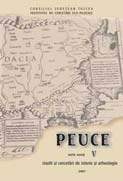Câteva consideraţii privind activitatea monetăriei de la Histria în epocă autonomă prin prisma tipului „Apollo”
Some Considerations Regarding the Monetary Activity from Histria During the Autonomous Epoch Seen through the „Apollo” Type
Author(s): Gabriel Mircea TalmaţchiSubject(s): Archaeology
Published by: Institutul de Cercetari Eco-Muzeale Tulcea - Institutul de Istorie si Arheologie
Keywords: Dobrudja; Histrian coinage; Autonomous Greek Age; Dobrogea; monetăria histriană; epoca greacă autonomă
Summary/Abstract: This article has been occasioned by the identification, within the framework of the numismatic collection of the National History and Archaeology Museum of Constanţa and another public and private, of various coins, emitted by Histria during the autonomous period. Thus, we have taken into consideration a series of coins that have been struck with the side image of Apollo’s head on the obverse, to which we add those that are only presumed to belong to the same deity; the difficulty in appreciating it consists of the differences of rendering the respective visage, as the traits are different. Before properly discussing the coins from the catalogue above, we allow ourselves a few iconographic, epigraphic, metrological and chronological observations concerning the countermarking, all of them relative to the Histrian type Apollo and “Apollo?”. Returning to the coins that are present in our catalogue (without specifying some data and considerations concerning their iconography, metrology and chronology, mentioned in the above commentary), we notice that they have been discovered in Baia (Tulcea County), Cerbu (commune of Topolog, Tulcea County), Sinoie (commune of Mihai Viteazul, Constanţa County), north of Dobrudja and in the city of Histria (commune of Istria, Constanţa County), in the area of the X plateau, sometime during the ’90s. They are all the result of some fortuitous discoveries; in other words, we do not have archaeological or other types of contexts. They were initially part of a private collection, and they were sold or donated to the Museum of Constanţa or is part today of private collection. The coins of the type Apollo are present through five items (big modul), of which one is of the so-called “Fedeşti” type. One of the other two pieces displays a countermark on the obverse, but, unfortunately, it cannot be identified, because of the bad state of preservation of the coin. The ones with a small diameter are much more interesting; most of them have been included in the category of the ones that are presumably part of the type Apollo, and identified with this divinity, but always bearing a most welcome question mark. The type “Apollo?” has been presented in different variants, in the work that appeared in the year 2000, Sylloge Nummorum Graecorum. Vol. XI. The Wiliams Stancomb collection of coins of the Black Sea region. Besides these existing variants, present also in our catalogue, in their totality (nr. 10-21), we must add some other variants of the same type; the differences are due to the iconographic details, changing from one item to the next (nr. 22-27). Not to mention the fact that, nevertheless, the three items that we have catalogued at nr. 182, in conformity with the above mentioned work, resemble rather than perfectly identify with the image that appeared on plate VIII. Finally, the last one (nr. 28 in the catalogue), belongs to a type catalogued as “Apollo or Dionysus”, although, from our point of view, it is the type D
Journal: Peuce (Serie Nouă) - Studii şi cercetari de istorie şi arheologie
- Issue Year: V/2007
- Issue No: 5
- Page Range: 161-182
- Page Count: 22
- Language: Romanian

